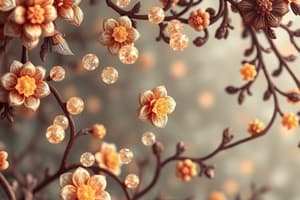Podcast
Questions and Answers
What is the primary end product of nitrate reduction in bacteria?
What is the primary end product of nitrate reduction in bacteria?
- Nitrogen gas (correct)
- Sulfide
- Ammonia
- Nitrite (correct)
How does anaerobic respiration contribute to food production?
How does anaerobic respiration contribute to food production?
- By breaking down glucose to sustain aerobic respiration
- By increasing the acidity in food products
- Through fermentation processes in foods like yogurt and beer (correct)
- By utilizing oxygen to enhance flavor
Which glucose transporter is primarily responsible for the uptake of glucose in most cells?
Which glucose transporter is primarily responsible for the uptake of glucose in most cells?
- GLUT2
- GLUT4
- GLUT3
- GLUT1 (correct)
Which of the following glucose transporters is regulated by insulin to increase glucose uptake in muscle tissues?
Which of the following glucose transporters is regulated by insulin to increase glucose uptake in muscle tissues?
What role does GLUT2 play in the body?
What role does GLUT2 play in the body?
Which process primarily allows organisms to survive in anoxic environments?
Which process primarily allows organisms to survive in anoxic environments?
Where is GLUT5 primarily found and what does it absorb?
Where is GLUT5 primarily found and what does it absorb?
What overall significance does anaerobic respiration hold for many organisms?
What overall significance does anaerobic respiration hold for many organisms?
Which amino acid is NOT classified as a ketogenic amino acid?
Which amino acid is NOT classified as a ketogenic amino acid?
What is produced from acetyl-CoA in the Krebs cycle?
What is produced from acetyl-CoA in the Krebs cycle?
What can be a consequence of excessive consumption of ketogenic amino acids?
What can be a consequence of excessive consumption of ketogenic amino acids?
Which of the following is a primary ketone body produced during the conversion of ketogenic amino acids?
Which of the following is a primary ketone body produced during the conversion of ketogenic amino acids?
What does the Krebs cycle primarily produce as a result of its reactions?
What does the Krebs cycle primarily produce as a result of its reactions?
Where does the Krebs cycle occur in eukaryotic cells?
Where does the Krebs cycle occur in eukaryotic cells?
Which substance enters the Krebs cycle when it combines with oxaloacetate?
Which substance enters the Krebs cycle when it combines with oxaloacetate?
What are ketone bodies primarily used for?
What are ketone bodies primarily used for?
What is produced during the conversion of succinyl-CoA to succinate?
What is produced during the conversion of succinyl-CoA to succinate?
Which of the following is a key function of the Krebs cycle?
Which of the following is a key function of the Krebs cycle?
Which reaction pathway statements accurately describe anaerobic respiration?
Which reaction pathway statements accurately describe anaerobic respiration?
How does fumarate convert to malate in the Krebs cycle?
How does fumarate convert to malate in the Krebs cycle?
What type of organisms primarily use alcohol fermentation?
What type of organisms primarily use alcohol fermentation?
What factors regulate the Krebs cycle?
What factors regulate the Krebs cycle?
Which end product is not typically associated with anaerobic respiration?
Which end product is not typically associated with anaerobic respiration?
During which specific reaction does NADH get produced in the Krebs cycle?
During which specific reaction does NADH get produced in the Krebs cycle?
What role does fructose-2,6-bisphosphate (F-2,6-BP) play in glycolysis?
What role does fructose-2,6-bisphosphate (F-2,6-BP) play in glycolysis?
How does high ATP concentration affect glycolysis?
How does high ATP concentration affect glycolysis?
What is the effect of insulin on the regulation of glycolysis?
What is the effect of insulin on the regulation of glycolysis?
Which hormone is known to inhibit glycolysis?
Which hormone is known to inhibit glycolysis?
What effect does citrate have on glycolysis?
What effect does citrate have on glycolysis?
What is the overall function of glucose transporters in metabolic processes?
What is the overall function of glucose transporters in metabolic processes?
Which factor is NOT involved in the regulation of glycolysis?
Which factor is NOT involved in the regulation of glycolysis?
What signifies the energy status of a cell during glycolysis?
What signifies the energy status of a cell during glycolysis?
Flashcards are hidden until you start studying
Study Notes
Ketogenic Amino Acids
- Group of amino acids converted into ketone bodies in the liver during low carbohydrate intake.
- Ketone bodies serve as alternative energy sources for the brain and tissues when glucose is scarce.
- Key ketogenic amino acids: Leucine, Lysine, Phenylalanine, Tyrosine.
- Conversion process: Amino acids are broken down into acetyl-CoA, leading to the production of acetoacetate and beta-hydroxybutyrate.
- Significant benefits include providing energy, promoting weight loss, and offering neuroprotective effects beneficial for conditions like Alzheimer's and epilepsy.
- Excessive consumption can disrupt amino acid metabolism; healthcare consultation is recommended before dietary changes.
Krebs Cycle
- Also known as the citric acid cycle, it occurs in the mitochondria of eukaryotic cells and the cytoplasm of prokaryotic cells.
- Input includes Acetyl-CoA from the breakdown of carbohydrates, fats, and proteins; output consists of carbon dioxide, ATP, NADH, and FADH2.
- Involves a series of oxidation reactions resulting in energy production via ATP synthesis.
- Steps include conversion of Acetyl-CoA to citrate, oxidation to isocitrate and further products, producing ATP and reducing equivalents NADH and FADH2.
- Produces intermediates for amino acid synthesis and gluconeogenesis, and regulated by acetyl-CoA availability and energy needs of cells.
Anaerobic Respiration
- A form of cellular respiration occurring without oxygen; generates ATP when oxygen is limited.
- Less efficient than aerobic respiration but vital for survival in anoxic environments.
- Primary differences: Oxygen is required for aerobic respiration, while anaerobic respiration uses alternate electron acceptors such as nitrate or sulfate.
- Common end products include lactate and ethanol, resulting from lactic acid fermentation and alcohol fermentation, respectively.
- Important in food production (e.g., yogurt, beer) and wastewater treatment processes.
Glucose Transporters
- Proteins in cell membranes that aid glucose transport, crucial for maintaining glucose homeostasis.
- Types of glucose transporters include GLUT1 (general uptake), GLUT2 (liver, pancreatic function), GLUT3 (neuronal efficiency), GLUT4 (insulin-responsive tissues), and GLUT5 (fructose absorption).
- Facilitate glucose uptake and glucose sensing; regulated by insulin and glucose levels in the body.
- Insulin increases GLUT4 translocation to enhance glucose uptake in muscle and adipose tissues.
Regulation of Glycolysis
- Essential for maintaining cellular energy balance and ensuring glucose is metabolized efficiently.
- Fructose-2,6-bisphosphate (F-2,6-BP) is a key allosteric activator of the rate-limiting enzyme phosphofructokinase-1 (PFK-1).
- ATP inhibits glycolysis, while AMP stimulates it, indicating cellular energy status through the AMP/ATP ratio.
- Citrate functions as an inhibitor of PFK-1, signaling sufficient energy production.
- Hormonal regulation: Insulin promotes glycolysis, enhancing F-2,6-BP synthesis, whereas glucagon inhibits it, favoring gluconeogenesis.
- The regulation is a complex interplay of multiple factors to maintain energy homeostasis.
Studying That Suits You
Use AI to generate personalized quizzes and flashcards to suit your learning preferences.




